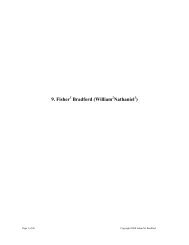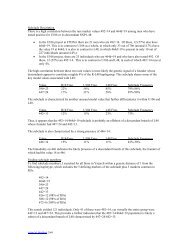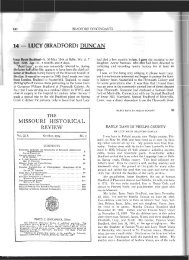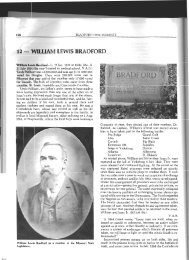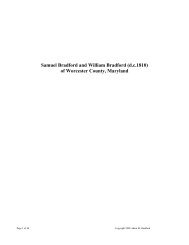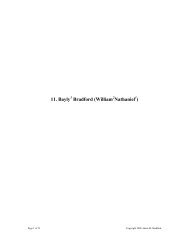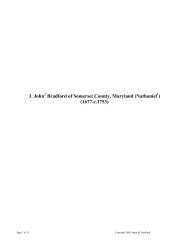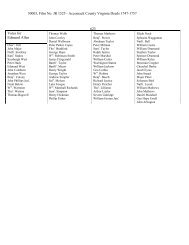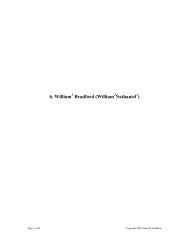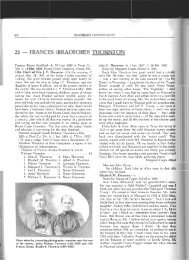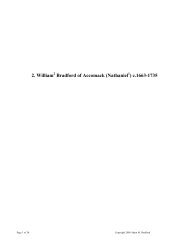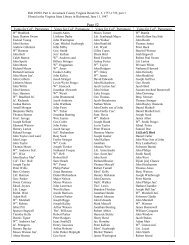1. Nathaniel Bradford of Accomack County, Virginia - Lower ...
1. Nathaniel Bradford of Accomack County, Virginia - Lower ...
1. Nathaniel Bradford of Accomack County, Virginia - Lower ...
You also want an ePaper? Increase the reach of your titles
YUMPU automatically turns print PDFs into web optimized ePapers that Google loves.
The occupation <strong>of</strong> currier no longer exists, its function having largely been incorporated into the tanning<br />
process and the actual work <strong>of</strong> treating and finishing hides taken over by machines, but at one time curriers<br />
were an integral part <strong>of</strong> the production and manufacture <strong>of</strong> leather. Before the 19 th century, the currier<br />
occupied the middle step in the leather trade between the tanning <strong>of</strong> the animal hide and its transformation<br />
into a manufactured good. After an animal was killed and skinned, the<br />
hide was first delivered to the tanner, who removed any remnants <strong>of</strong><br />
blood or tissue from the hide and then “limed” it – a process which<br />
involved washing the hide repeatedly in quicklime to prepare it to absorb<br />
the tanning solution. Next the tanner cut the hide to a useable size and<br />
dipped it in a series <strong>of</strong> solutions until the hide was thoroughly tanned.<br />
Then the hide was delivered to the currier, whose task was to finish the<br />
leather so it could be turned into a useable product, such as a saddle or a<br />
shoe.<br />
First the currier stretched the leather on a frame or rack until taut. Then he worked<br />
the hide with a “sleeker”, a short-bladed knife, to force out lingering tanning fluid.<br />
The main tool <strong>of</strong> the currier’s trade was a different implement known as the<br />
currying knife. First the currier used this implement to shave the inner surface <strong>of</strong> the<br />
skin until smooth, then to split the leather into different widths depending on its<br />
intended use. For shoe manufacture, the more pliant leather was used for the upper<br />
parts, and the stiffer leather for the soles. Having trimmed the hide, the currier<br />
began the actual currying process, which consisted <strong>of</strong> rubbing beef tallow and cod<br />
liver oil into the leather to finish it. At that point, the leather could be used for a<br />
multitude <strong>of</strong> purposes and stained or dyed. 68<br />
The whole leather trade was intimately inter-connected and each craftsman involved, from the tanner to the<br />
cobbler, relied heavily on the others. In medieval England <strong>of</strong>ten many members <strong>of</strong> the same family<br />
engaged in different aspects <strong>of</strong> the trade, so that the tanner, the currier and the cobbler or saddler were all<br />
related. In fact, it was quite common in England to find curriers also engaged in tanning and the<br />
manufacture <strong>of</strong> shoes. This ended up being the case with <strong>Nathaniel</strong>.<br />
Before entering into the pr<strong>of</strong>ession <strong>of</strong> a currier one typically had to serve an apprenticeship to learn the<br />
trade. Since so little is known <strong>of</strong> <strong>Nathaniel</strong>’s early life, it is unclear where <strong>Nathaniel</strong> learned the craft <strong>of</strong><br />
currying, whether he served an apprenticeship on the eastern shore or elsewhere in the colonies or England;<br />
whether he learned it in the service <strong>of</strong> a stranger or an acquaintance or whether it was a family pr<strong>of</strong>ession,<br />
knowledge <strong>of</strong> which might have been passed on to him by his relatives.<br />
Page 15 <strong>of</strong> 74 Copyright 2008 Adam M. <strong>Bradford</strong>




